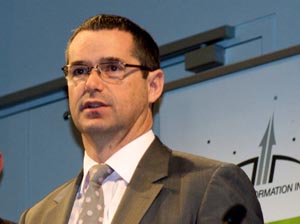Long wait for tech-ready media laws

It could be two years or more before legislation stemming from a top-to-bottom legislative review to shake up existing media laws will appear, according to Communications Minister Stephen Conroy.

Stephen Conroy (Credit: David Braue/ZDNet Australia)
In Conroy's keynote speech to drum up Labor's IT credentials to around 200 IT industry leaders at an Australian Information Industry Association (AIIA) lunch in Melbourne this week, Conroy said a fundamental review of Australian media policy had become essential because the rapidly changing converged media environment had rendered obsolete existing legislation controlling the behaviour of telecommunications and broadcast players.
"Given that convergence is now in your lounge room, it might be a good idea if the Parliament caught up," Conroy told the audience. "The government's policies and actions, particularly in creating the NBN and pursuing the switch to digital television, have rapidly accelerated the arrival of the convergent media age in Australia after years of delay. Literally, technology has run over the top of existing legislation."
One example Conroy offered was current regulations that limit audience reach: section 53 of the Broadcasting Services Act, for example, restricts single organisations from controlling television broadcast licences whose combined licence area exceeds 75 per cent of the population of Australia. "As soon as someone starts streaming live on the internet, by definition they reach 100 per cent of Australian homes," Conroy said.
The review, which would be kicked off in the event of a Labor re-election, will see consultation on terms of reference lasting until the end of 2010, at least 12 months' worth of soliciting and considering submissions from industry and other stakeholders, and then draft legislation for consideration the year after.
"I'm not envisioning that it would be until 2012 that you'd start seeing debate around the legislation," Conroy told journalists after delivering his speech at the AIIA lunch. "Parliament being parliament, it will have a robust policy debate, and that it will be controversial I have no doubt. This will be the most challenging part of my portfolio."
The terms of the review will span free-to-air and subscription TV as well as video on demand, IPTV and mobile TV, with specific focus on areas such as licensing regulations, regulatory obligations and consumer protection obligations.
Protection of Australian content regulations would "remain at the centre of our approach to regulatory reform", Conroy added. "As international content competes ever more fiercely for Australian audiences, we must look at how we can continue to deliver that content in the future."
Simplifying government
Questioned by AIIA CEO Ian Birks as to how industry could interface with government more effectively, Conroy also hinted that the future could see some changes in the way ICT-related government policy is handled.
Conroy noted that a raft of different government departments and policymakers are individually responsible for areas such as cybersecurity, e-health, innovation and IT, legal regulations, education, smart grids and more all split between various government departments.
"It is not easy being right there across so many different departments," Conroy said, citing the three years' work that went into the recently-passed e-health legislation as a key example. "My next great challenge — apart from the structural separation of Telstra — is convincing a few bureaucrats that it's actually worthwhile to try and work in a much closer way together around the government's messages, the government's policies and the government's services.
"The government has to step up and say that it's just a bit difficult to have all of these things in so many different areas."